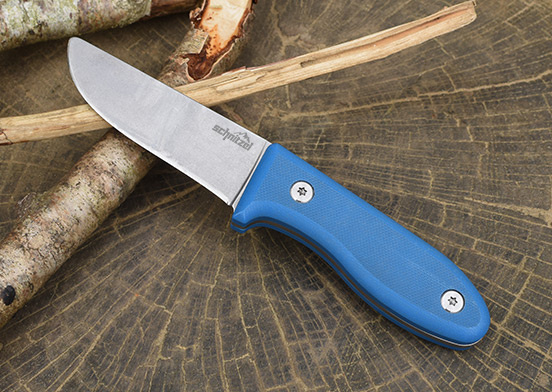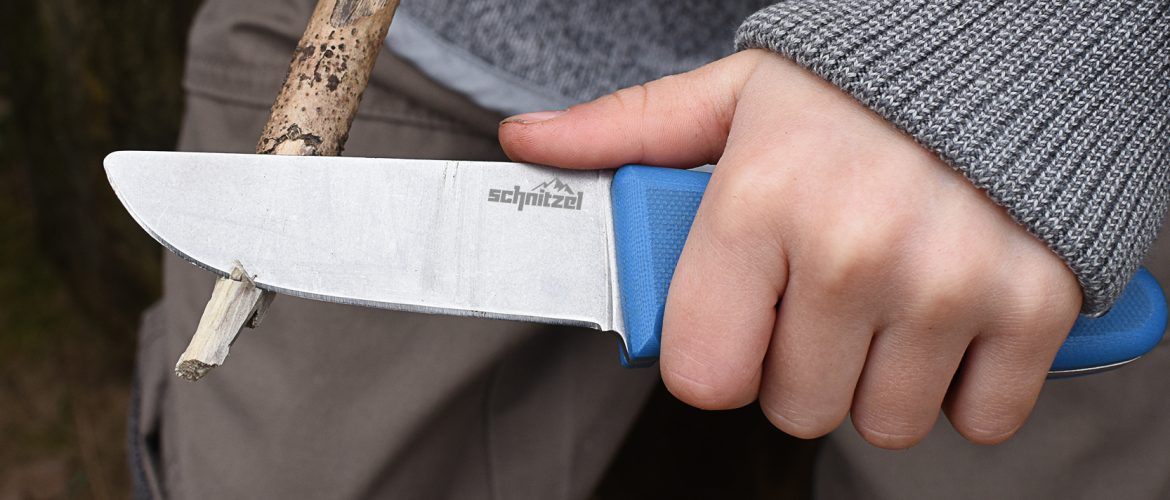Clear rules for carving with children
As knives are sharp objects, you need to establish clear rules from the very beginning. Whilst our products are perfectly designed for small hands, particular safety precautions should still be observed.
1.) Your child should always stay sat down: “Whittling means sitting” is the number one rule!
2.) Correct posture whilst carving: To ensure a safe grip on the knife, your child should sit legs apart, feet placed firmly flat on the ground. The upper part of the body should be slightly bent forward, with the arms resting on the thighs.
3.) Make sure that your child always keeps a safe distance of two arm’s lengths (approx. 1 metre) to anyone else whilst carving.
4.) Carving with a sharpened blade minimises the risk of injury as you have to exert less pressure on the knife.
5.) Any carving movement should always be directed away from your body.
6.) The blade should always be safely re-sheathed immediately after use.
7.) Removing bark from living trees is a no-no.
As a matter of principle, wood carving should always be supervised by an adult. It is also essential here that parents act as exemplary role models: If you do not conscientiously follow your own rules, your child will most likely not observe the safety precautions either.
From what age should a child be allowed to use an outdoor knife?
Many customers ask us how old children need to be to use a child’s knife. There is no generally applicable answer to this question, as every child develops at his/her own pace. As a basic principle, a child should be able to hold the knife securely and to comprehend and follow the safety rules for the use of woodcarving knives.
Most children start between 5 and 8. However, this is only a rough guideline. The most important thing is to provide the children with support in the learning process and to ensure that they abide by the ground rules right from the start. However, it is ultimately up to you to decide at what age your child can be considered „mature“ enough to handle a knife.


Tips for carving wood with children
Children have only limited strength in their hands and beginners may quickly reach their limits with their first attempts at carving. In order to avoid frustration and keep things as safe as possible, the knife should always be kept sharpened. It is easier to slip with a blunt knife. Soft wood, for example fresh green wood from a hazel tree or willow tree, is also ideal for starting out. Besides, following the direction of the wood grain requires less effort, with the added benefit that the wood will not fray or split.
The projects should be kept simple for newbies to start with. A nice first project, for example, is sharpening a stick to use as a skewer to bake bread on a campfire. The knife’s handling can also already be practiced when making the bread, for example by letting the children chop up a few herbs to add to the dough. Some chopped tomatoes or diced ham will also make the dough tastier.
Once your child has managed the first projects and learnt how to handle the knife, you can then move on to more challenging whittling tasks. At this stage, it is however still advisable to opt for simple shapes without elements that are too thin. Mushrooms, fishes or seals are popular designs for beginners but you can also let your imagination run free.
Children particularly love making hiking sticks. You just need a straight, dry branch from the woods and you’re ready to go. The first step is to carefully remove the bark. Then sharpen the narrower end of the branch and round off the broader end. The walking stick can thereupon be decorated at will with all sorts of symbols and patterns. If at hand, the stick’s surface can be finished with sandpaper. Going on a hike is even more fun when you can take your very own self-made walking staff along with you!
- Children’s knives should always be kept sharpened.
- Soft, fresh wood is easier to carve.
- Always cut in the direction of the wood grain.
- Keep woodcarving and outdoor activities simple at the beginning.
- You can move onto more challenging carving projects at a later stage.

